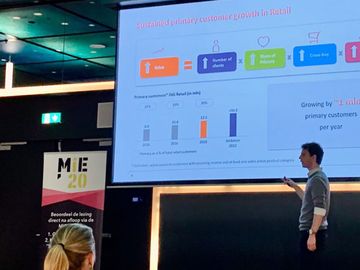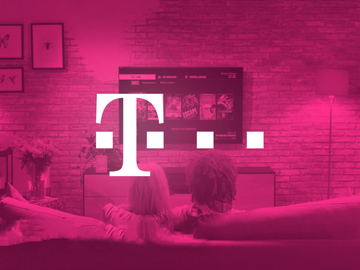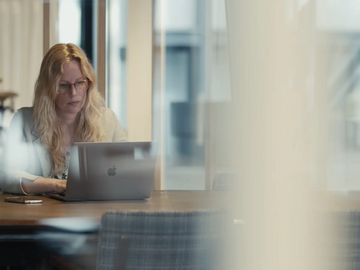
Ivonne van den Heuvel & Martijn Schuijff (ANWB): “Winning is no guarantee for future success”
In March 2018, ANWB managed to win first place for the tenth time in a row in WUA’s Web Performance Scan Car Insurance. A unique achievement, unparalleled in the history of customer experience benchmark research at WUA. Ivonne van den Heuvel is Commercial Director at ANWB Insurance, Martijn Schuijff is Manager Insurance at ANWB. A chat about putting customers at the heart, e-bikes with chips, and influencing consumer behavior for safer traffic.
Ivonne and Martijn, congratulations with this tenfold victory in this WUA study. This must have made a few waves within the ANWB organization?
Ivonne van den Heuvel (IH): “We’re incredibly proud and happy and this does make a lot of waves in the organization. It’s not a fait accompli, so in that sense, it’s always a goal to win this first place. Especially given the fact that in all of WUA’s studies, there’s never before been a ten-time winner by the same party in a different category or industry, was amazing!”
Martijn Schuijff (MS): “It’s not like we’re just going to laze about now. Every day, it’s important to keep track of developments in the market. They happen so fast, especially in technology. ANWB is constantly taking these developments into account.”
How important is it to you to be the best in the digital arena? What does it mean to you, to win ten times in a row?
MS: “We work for ANWB, and we distinguish ourselves from the competition by who we are as a company and association. I think that gives us a head start. We have a great team, multidisciplinary, that can switch fast and come up with ideas and execute them.”
IH: “In all these years of winning, we’ve never really had a ‘satisfied’ feeling. Perhaps it’s just not as present in ANWB’s corporate culture. We’re quite down to earth like that. This recognition is beautiful, but things could change in a minute as well. That realization isn’t taught, it’s deep within us. Winning, even ten times in a row, is fun and great, but it doesn’t guarantee any future success.”
What’s your approach, what’s going so well? What can others who are responsible for digital learn from your approach?
MS: “The most important thing that’s going well at ANWB, and a priority within our approach, is detecting customer needs, and catering to them. The implementation and further development of the chat function as a way of communicating is a great example of this. We had already thought this would be the future back in 2012, but recently, our customers have started to appreciate it, too. We’re constantly measuring customer experience, and looking at what we can optimize. How do customers move through our pages, how do they experience the funnel, or things like a ‘comparison tool’? It’s important to bring all disciplines together, and find creative solutions. We also use a dedicated IT team to create adjusted designs, and keep going at high speeds.”
IH: “The head start we had in agile working has since been made irrelevant. Competitive advantages are achieved by being smart and creative and by making it possible to have high speed developments. But the most important thing is the quality of the people on the team.”
MS: “Yes, the speed we have at ANWB in decision-making, that’s one thing I think is an important strength of our approach. After a meeting, we can make decisions immediately, keeping the speed of development and improvement.”
What are your views on service and sales, and the blurring of the borders between these two blood types? How do you deal with this at ANWB?
IH: “At a company like ANWB, sales is a consequence of service. They’ve never been apart from each other. Sales and service are intertwined with an identical approach. That way, we create consistency in customer promises and brand experience.
Customers look for contact options, and that’s done online more and more. Whether it’s to take out a service, to change something, or to file a claim: they want to do it digitally. This is a full-fledged medium, and you need all functions in a user-friendly way. Our experience is that customer satisfaction rises even further when self-service leads to good experiences for the customer.
Service is a broad concept. When we offer service, it might mean advising a customer on taking out an additional policy, but it can also mean the advice is to cancel an insurance policy or a part of it. When we look at the publicly accessible part of the website – so not the customer’s ‘MijnOmgeving’ environment, it’s the most important thing in service to make sure consumers feel understood and comfortable right away.”
What’s the role of customer research and putting the customer at the center in your daily job, and in the teams you’re responsible for? How is that organized at ANWB?
MS: “These days, we have our own UX center at the headquarters in The Hague. There, ANWB Insurance does monthly studies, specifically on travel and car insurance products. We also do ad-hoc and continuous studies. We continuously measure NPS, using all sorts of different online analyses.”
IH: “The information we receive is very relevant to us. For historical comparisons, we use the NPS, but as KPI we also look at the Customer Effort Score more and more often. That one’s mostly important in self-service environments.”
MS: “For sales, it’s a matter of constantly using analytics, an operational process we use every day. We do the development with SCRUM, and operation from either mobility or recreation. Together with the commercial team, we look at the results, while we look at the developments, and adjustments with the SCRUM team. This is where everything, online and offline, comes together. In a weekly stand-up, these results are shown, but we divide them into mobility or recreation.”
MS: “Gearing towards conversion remains the most important thing, but you can always measure more, and therefore know more. You can meet your customers’ needs better, resulting in a higher conversion. An example of this is the chat: it’s a way for us to help our customers faster and easier. It’s important to remember: if you’re doing this exclusively for conversion, it won’t work. If you put the customer central, then it’ll work.”
What are your digital challenges for 2018-2019?
IH: “We want to win the WUA Travel Insurance study for the fifth time!”
MS: “Things that are possible digitally aren’t necessarily the best for customer comfort. An example of this are ‘chatbots’. If it’s just a simple FAQ, it doesn’t add any value. We have technological solutions, but the most important question is how you’re going to use it. We can offer so much more in a ‘MijnOmgeving’ customer environment. We have the technological options, but if customers don’t care for them, you need to be careful in offering new technological options.”
IH: “Yes, timing is important! Also in where you can be – and want to be – in digital as an organization. You need to be able to feel when a certain technological option becomes relevant for the customer. A great example is our innovation in bicycle insurance. Your (electronical) bike is microchipped, so we can find it back quickly in case it’s stolen, along with an external partner. This insurance policy has some other great additions: if you run into problems with your bike, the ANWB Wegenwacht (Roadside Assistance) knows exactly where you are. Stealing bicycles is a great social problem, expensive e-bikes are ‘in’, so the timing of this proposition seems perfect to me.
“It’s interesting to use new technological possibilities to enrich our insurance proposition. We experiment with new technology like artificial intelligence and machine learning. We’re also working on blockchain experiments. All new technological advances are tested so we can apply them when necessary.”
How do you make sure the right people are working at ANWB?
MS: “We work with multidisciplinary teams: that ensures it’s automatically interesting to specialists to work for us. We also invest a lot in young people, educating them within ANWB and offering them many opportunities.”
I’d guess baby boomers are probably ANWB members more often than younger generations. Are you testing this as well? Or: how do you handle this?
MS: “We have 4.5 million members, and they’re a good cross section of average Dutch people. Most of our customers make a little more money than average, are maybe a little older, but not by much. By the way, I feel like segmenting by age group is outdated. ANWB is working towards more and more personalized offers and personalized controls. It doesn’t matter how old you are.”
IH: “The Safe Driving insurance product for example, which is highly attractive to young people. It gives them a discount if they drive safely. That means you control how high your insurance fee is. That’s what’s important in society right now: people want to take control, and be responsible for things themselves. This trend calls for a more thorough digitalization in which self-service is a priority. For us, as ANWB, it’s important that with this policy, we’re making our roads safer.”


